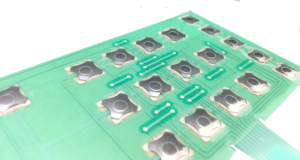Leading Benefits of Incorporating a Membrane Switch Into Your Digital Equipment
Leading Benefits of Incorporating a Membrane Switch Into Your Digital Equipment
Blog Article
Recognizing the Functionality of Membrane Layer Switches for Interface Instruments
The performance of membrane switches stands for a significant development in customer interface style, combining effectiveness with aesthetic adaptability. As industries significantly prioritize individual experience, understanding the nuances of membrane layer switch technology comes to be vital.
What Are Membrane Switches?
Membrane layer buttons are ingenious user interface gadgets that facilitate individual interaction with electronic equipment. These flexible parts include numerous layers, including a graphic overlay, spacer, and a printed circuit layer. The style enables a smooth assimilation into numerous digital devices, improving both the visual and practical aspects of individual interfaces.
Membrane buttons are commonly utilized in a variety of applications, from home home appliances to industrial machinery and medical tools. Their building and construction typically features a slim account, making them a perfect choice for portable designs. The responsive comments given by these switches can be engineered to meet certain individual preferences, guaranteeing effective interaction in between the user and the tool.
Longevity is one more substantial benefit of membrane switches, as they are resistant to dirt, moisture, and chemicals, which enhances their life expectancy sought after settings. Additionally, these buttons can be tailored in terms of form, size, and graphic design, enabling branding and user-specific features. In general, membrane changes represent a functional option for enhancing user experience in electronic devices, combining performance with aesthetic charm in a reliable way.
How Membrane Switches Work
Operating on an uncomplicated principle, membrane layer changes use a split construction to sign up customer input efficiently. Each button consists of numerous layers, consisting of a printed circuit layer, a spacer layer, and a leading visuals layer, which are made to function with each other seamlessly. When a customer presses the leading layer, it compresses the spacer layer, bringing the conductive components of the circuit layer right into contact with each other.
This contact develops a closed circuit, indicating the device to perform a particular function. The design enables numerous configurations, consisting of responsive comments, which can boost the customer experience by supplying a physical feeling upon activation. The materials used in membrane buttons typically include adaptable substratums, such as polyester or polycarbonate, which ensure longevity and durability versus wear and tear.

Secret Benefits of Membrane Layer Buttons

One more significant advantage is their density. Membrane switches are slim and lightweight, which enables makers to conserve area in their gadgets without compromising capability. This attribute is specifically useful in applications where weight and quantity are essential considerations.
In addition, membrane buttons are immune to dirt, dampness, and chemicals, improving their resilience. This resilience extends their life expectancy and decreases the demand for constant substitutes, causing price savings over time.
In addition, the tactile feedback given by membrane switches can be maximized to enhance user communication. They can include features such as raised switches or distinct clicks, enhancing functionality and individual experience.
Applications Across Industries
Interface gadgets making use of membrane layer buttons are widespread in a vast range of sectors, showcasing their flexibility and functionality. Membrane Switch. In the anchor medical industry, membrane switches are imp source important to gadgets such as diagnostic devices and client surveillance systems, where their sturdiness and ease of cleansing are vital for maintaining hygiene requirements. Likewise, in the vehicle industry, these buttons are used in dashboard controls and infomercial systems, giving a streamlined and modern interface for individuals.
Furthermore, the consumer electronic devices market gain from membrane layer switches in devices and handheld devices, where portable style and easy to use interfaces boost individual experience. Industrial applications likewise take advantage of membrane layer changes for control board in machinery and automation systems, emphasizing their toughness and resistance to extreme settings.
In the aerospace and defense sectors, membrane buttons are made use of in cabin controls and devices, where dependability and performance under extreme problems are paramount. Furthermore, the video gaming sector significantly incorporates membrane buttons in controllers and arcade equipments, contributing to an interesting individual experience. On the whole, the adaptability of membrane layer switches over allows their prevalent use across numerous industries, highlighting their significance in contemporary interface layout.
Future Fads in Membrane Layer Change Modern Technology

Furthermore, making use of advanced products, such as polycarbonate and polyester films, is anticipated to rise, providing enhanced resilience and resistance to ecological stressors. These materials add to the overall durability of membrane layer buttons, making them ideal for harsher commercial applications.
Furthermore, the consolidation of clever technology, consisting of IoT connection, will allow membrane buttons to communicate with other tools and systems, helping with a more interactive customer experience. This pattern lines up with the expanding demand for smart devices across various markets, from health care to consumer electronic devices.
Last but not least, customization options are expected to broaden, allowing suppliers to produce bespoke remedies tailored to specific individual demands and preferences. These growths will position membrane buttons as crucial elements in the development of individual interface innovation.
Final Thought
In verdict, membrane switches over represent an essential advancement in customer interface technology, offering a reputable and functional service for varied electronic applications. As advancements in product science and touch noticing modern technologies proceed, the capability and applicability of membrane layer buttons are expected to increase, strengthening their value in modern-day digital tools.
Report this page